
9 Tips for Creating a Social Media Advocacy Campaign
Social media is one of the most powerful tools for activating people to take action. Amidst the constant stream of news updates, social media advocacy campaigns offer people a relevant way to make a difference on the issues they care about. As we enter an era of record-breaking advocacy numbers, here are 9 tips for positioning your advocacy campaigns on social media:
1. Center your campaign around timely events
The best time to drive action is when an issue is in the news or trending on Twitter. This is a critical time for participating in relevant social media conversations and using trending hashtags in your posts. For example, following breaking news that Texas was implementing an abortion ban, the Center for Reproductive Rights urged their social media audience to contact Congress to support the Women’s Health Protection Act to protect abortion nationwide. While supporting this piece of legislation has been an ongoing campaign for the Center for Reproductive Rights for years, this was a pivotal moment for the campaign due to the media spotlight on abortion access.

2. Build in relevancy whenever possible
Not every advocacy issue becomes a trending topic, so it’s important to create relevancy whenever possible. If your advocacy goal is to get a bill passed, plan for posts when a bill is introduced, create posts if the bill gets any press mentions and do another push when the bill is about to go to vote. For example, Color of Change created a renewed sense of urgency for their clemency campaign by creating a post highlighting it’s the “last day to push Congress” to take action on the issue.
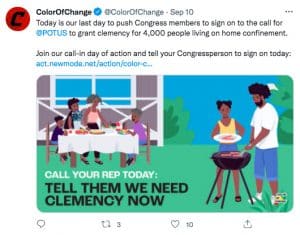
You can also look for creative opportunities to create relevancy. For a campaign advocating for federal Marine protection, NRDC created a social media post celebrating the Northeast Canyons and Seamounts’s 5th birthday as a way of reminding readers of the importance of protecting marine habitats.
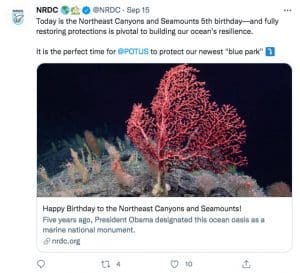
3. Tag the campaign target—and influencers, journalists, and partner orgs
A critical piece of advocacy is reaching the target you are trying to influence. Here, Color of Change calls out Google by both tagging them and prominently featuring their logo in a series of social posts. Because the campaign directly called out Google and included a unique hashtag (#BeyondTheStatement), it’s highly likely there were employees at Google following the hashtag and monitoring reactions on social media.
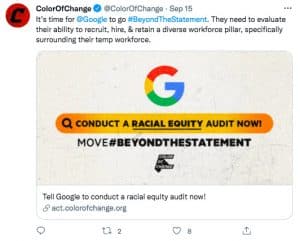
It’s also important to go beyond just tagging the target—be sure to include relevant influencers, journalists and partner organizations that can help your cause. If they’ve already posted in support of the issue, one way to engage them is to thank them for their support. This can earn you a reshare or it can even become the start of building a deeper relationship—potentially earning your organization a new ambassador, a press mention or even a new partnership.

4. Break down larger issues into smaller pieces of content
In a campaign to build support for the $3.5 trillion Build Back Better spending bill, NRDC breaks down how the bill is an extraordinary opportunity for addressing several major environmental challenges. While the massive spending bill includes numerous economic initiatives, NRDC makes it easy for audiences to understand the importance of the bill by focusing on these specific issues.
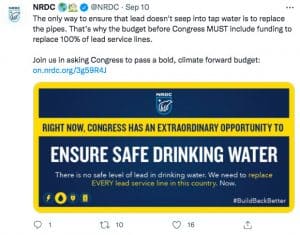
5. Acknowledge the power of advocacy
It’s important to reinforce to people that our voices matter—and that change only happens when people demand it. In this example, Color of Change reminds people that accountability for George Floyd was achieved because enough people cared to speak up.
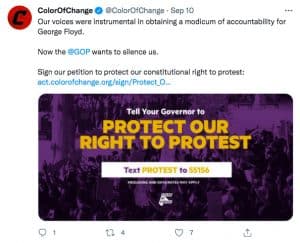
6. Show social proof
A powerful strategy to drive action is to show how many other people have taken action. People want to be included and are more likely to join a campaign when they hear that others like them have joined. For a campaign to influence Atlanta’s City Council, Color of Change invited people to add their name to the petition by highlighting that more than 10,000 Atlantans have already taken action.

7. Be persistent
Some advocacy campaigns take years to achieve success. For example, banning neonics has been an evergreen campaign for NRDC for years. Along with driving advocacy actions, NRDC’s neonics campaign also includes spreading awareness and deepening their audience’s understanding of the issue—all the while capturing new email subscribers.
8. Use UTM codes to track performance
If you are utilizing multiple social media channels, UTM codes can help you gauge the effectiveness of each channel at driving advocacy actions. Knowing how each channel performs will help you determine where to prioritize posting—and if you need to adjust your strategy for low-performing channels. Read more on UTM tracking best practices here.
9. Celebrate your successes!
Celebrating successes—small and large—is a great way of engaging your existing supporters and motivating new supporters to join your campaign. Besides reaching your advocacy goal, examples of successes in an advocacy campaign could include reaching a target number of supporters or if a key influencer speaks up on the issue.
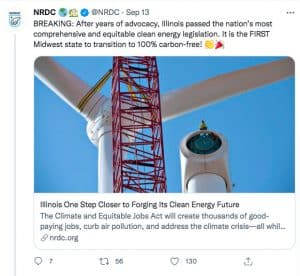
Final tip: If you are looking for an easy-to-use digital advocacy tool, check out Rally Starter, a platform designed for activists of all levels to create petitions, pledges, and more! Launch a campaign in 15 mins or less at rallystarter.com!